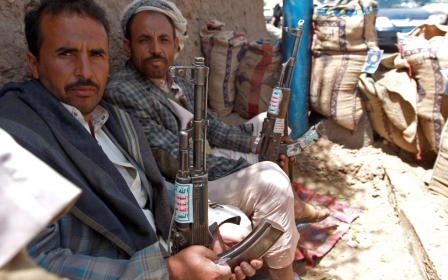Why the Houthis are taking a leaf from Hezbollah’s military playbook

While the Islamic State has monopolised attention in the region, there has been a seismic shift in Yemen’s political landscape in the past month that will have far-reaching consequences not only for Yemen, but for the wider region and the West. In recent months, the Houthis, an armed political movement based in the north of the country, swept southwards towards the capital Sana’a, effectively taking control of the city after four days of clashes with government forces on 21 September, and securing formal political concessions through a UN-brokered peace deal with Yemen’s president.
Since the September deal, the Houthis have maintained a large armed presence in the capital and set up checkpoints across the city. Their military might essentially extends their influence far beyond the power the group was granted through the peace deal, to virtual political monopoly in the capital, as one senior western diplomat put it.
Meteoric rise
The group’s meteoric rise from humble origins in the early 1990s, to what Yemen expert Gregory D Johnsen calls “the closest thing Yemen has to a kingmaker”, has been remarkable, leading many to ask how it has been possible at all. The group’s detractors – including Washington and Riyadh – say the Houthis are financed, advised and armed by Iran in much the same way that Tehran supports Hezbollah, the Lebanese Shia militia that is also alleged to have lent direct support to the Houthis in the past.
In some areas, including political and media support, there are clear links between the two. But evidence of military links, which both Tehran and the Houthis deny, is thin on the ground, and many experts feel that reports of ties to Iran are an overstated, or a politically-motivated accusation on the part of Tehran’s main regional rivals, including Washington and Riyadh, who are themselves responsible for having backed different Yemeni political leaders.
What is clear is that the Houthis are a well-experienced military force, which survived six wars with the central government from 2004-10. Since then, they made territorial advances that have seen their ambitions grow alongside their military arsenal, which includes tanks and huge quantities of heavy weapons.
Its followers are Zaydis, which is notably different from the Twelver school of Shia Islam followed by Hezbollah and the Iranian establishment. Unlike Hezbollah, the Houthis deny receiving military assistance from Iran and they do not embrace the Vilayat-e Faqih (Guardianship of the Islamic Jurists), essentially professing fealty to Iran’s supreme leader.
Yet while there are clear political and ideological differences between the two groups, on a strategic military level there are notable similarities. Writing over a week before the clashes in Sana’a that preceded the UN-brokered agreement, Dr Nabeel A Khoury, a senior fellow of Middle East and national security at The Chicago Council on Global Affairs, outlined numerous similarities between the Houthis’ strategy in Yemen, and political and military manoeuvres by Hezbollah since 2005, framing both developments in “the cold war going on between Saudi Arabia and Iran over the past decade”.
On a tactical level too, Khoury’s comments were notably prescient as the Houthi takeover of Sana’a shares numerous noteworthy similarities to events in Beirut in 2008, when Hezbollah gunmen seized control of much of Lebanon’s capital.
Both incidents began with the political mobilisation of opposition supporters to the capitals, which escalated until the point of conflict.
The street battles in Beirut and other areas of Lebanon that are known euphemistically as the “May events” of 2008 were the culmination of a political crisis between a government dominated by the Sunni Future Movement, and the Shia Hezbollah. Since late 2006, supporters of Hezbollah and its allies held numerous anti-government street protests and sit-ins in central Beirut, severely disrupting commercial operations in areas known to be Future Movement strongholds.
The catalyst for violence came in May 2008 when the government sought to fire the pro-Hezbollah head of security at Beirut’s airport and dismantle Hezbollah’s communications network, which runs in parallel to the state network and which the group says is an essential part of its conflict with Israel. In one week, Hezbollah gunmen and their allies overran areas of West Beirut that were defended by a small number of Sunni militiamen linked to the Future Movement. Dozens were killed in clashes in the capital and the surrounding mountains, before rival leaders signed a peace agreement in Qatar on 21 May 2008. The Doha Agreement, as it became known, gave the Lebanese opposition (of which Hezbollah was a leading member) veto-yielding power and brought in a new electoral law that reformed constituencies to the advantage of the opposition.
Popular resentment
Similarly, the Houthi takeover of Sana’a began as a popular protest that escalated into military confrontation. Houthis capitalised on popular resentment towards the government, an institution decried for mismanagement and corruption, to lead a campaign of civil unrest and provoke the government. It should be noted that anger towards the government was particularly high after a decision in late July to lift expensive fuel subsidies, a particularly biting austerity measure in a country where half the population live below the poverty line.
From 4 August tens of thousands of Yemenis joined Houthi-led protests in the streets of Sana’a, calling not only for the return of fuel subsidies, but also for the removal of the government. As the weeks dragged on, reports surfaced of armed Houthis positioned on rooftops close to government ministries as protesters became emboldened. Houthi leader Abdel Malik al-Houthi repeatedly warned President Hadi that the group would “respond” to force. On 9 September, the city held its breath after Yemen’s security forces opened fire on protesters who had gathered outside the prime minister’s office, killing seven Houthi supporters. Eight days later the Houthis responded with fierce clashes against the First Armoured Division, a component of the factionalised Yemeni army that is loyal to the powerful General Ali Mohsen al-Ahmar, before President Hadi agreed to remove his prime minister and sign the UN-brokered peace deal.
Similarities between the two cases are not confined to the strategies adopted by the belligerent parties. Casualty levels from both battles were relatively low, and damage to infrastructure mild in comparison to other urban conflicts. In both cases, meanwhile, the army’s role was minimal: the Lebanese army stayed out of the May 2008 conflict in order to avoid a splitting of the institution along sectarian lines as had happened during the Lebanese civil war. In Sana’a, battles were concentrated between Houthi militants and the army’s First Armoured Division, with other army units instructed to stay out of the fight. The fact that much of the army did not get involved in the fighting has generated all sorts of accusations about the Houthis being in cahoots with various external and internal powers, including former President Ali Abdullah Saleh.
But the Houthis’ territorial ambitions have not stopped at the capital, and in the past week, the group has seized parts of the Red Sea port of Hodeida and have pushed into Ibb, a stronghold of al-Qaeda’s Yemen branch. For countries that view the Houthis as an Iranian proxy, there is concern that the group will advance to Beb al-Mendeb, which is just 20 miles from Djibouti and potentially threaten one of the busiest shipping lanes in the world.
It is still too early to predict how events will turn out in Yemen, however the Houthis may find their military advances a gamble too far. Hezbollah shrewdly pushed the Lebanese government into accepting a peace deal that secured Hezbollah’s political power, while preventing an escalation that could have led to civil war. The Houthis would be wise to learn from Hezbollah’s political initiatives, as it appears to have learned from its military tactics, if Yemen too is to be spared another civil war.
Shane Farrell is a political analyst based in Dubai.
The views expressed in this article belong to the author and do not necessarily reflect the editorial policy of Middle East Eye.
Photo: Supporters of the Shiite Houthi movement block a road during a demonstration rejecting the presidential overture to replace the government and reduce a disputed fuel price hike in Sana'a on 3 September 2014 (AFP)
New MEE newsletter: Jerusalem Dispatch
Sign up to get the latest insights and analysis on Israel-Palestine, alongside Turkey Unpacked and other MEE newsletters
Middle East Eye delivers independent and unrivalled coverage and analysis of the Middle East, North Africa and beyond. To learn more about republishing this content and the associated fees, please fill out this form. More about MEE can be found here.





